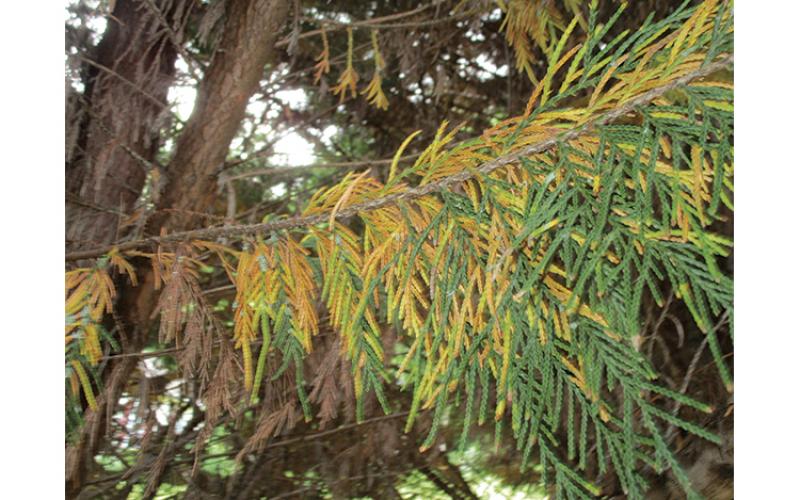Christine Bredenkamp
NC Cooperative Extension
Recently, I’ve received many inquiries regarding Leyland Cypress in the landscape. Homeowners are perplexed and wonder what’s wrong with their hedge as they attempt to describe a wide array of symptoms. These include yellow and or brown discoloration of branch tips and interior foliage, along with occasional dieback of entire limbs within a solitary tree or planting.
The Leyland cypress, known to the scientific community as Cuprocyparis x leylandii is a large evergreen tree that grows extremely fast and has the potential to grow up to and beyond 100 feet tall and almost half as wide. This species of tree originated from a cross of two North American conifers, the Monterey cypress and the Alaskan cypress and is prized for use as a hedge or screen due its fast rate of growth and its ability to grow in a wide range of soils and climates. These features coupled with a thick evergreen canopy makes the Leyland cypress one of the most widely planted trees in the landscape.
In observing these unsightly symptoms, one may wonder “What’s up with my Leyland cypress?” The browning of inner and lower foliage is quite common and occurs with increasing measure from too much shade. Quite frankly, hedges with taller, tightly spaced trees and overgrown limbs are prone to suffer more “internal browning” than trees spaced further apart that allow for wind and sunlight penetration. If symptoms increase in severity, then one of the following diseases such as Botryosphaeria Canker, Seridium Canker or phytophthora root rot may be the culprit.
Outside of natural browning that occurs from overgrown limbs, there are several reasons why these symptoms are showing up this year. Stressful environmental conditions created by a wet summer last year followed by a cold spell this spring increased the likelihood for root and or foliage infection. Branches or whole sides of a tree may display a dead zone when exposed to extreme cold temperatures with high winds. Hedges and landscape plantings that have poor drainage or where water “sits” for extended periods of time have an increased chance of infection by the root rot disease Phytophthora cinnamomi. Consider a scenario of a full-sun plant in a monoculture setting that grows 100 feet tall, 20 plus feet wide and planted 4 feet apart; this combination of too much shade and reduced air circulation creates a prime condition for “internal browning” and increases the chance for incoming diseases that may result in foliage death.
When symptoms first appear, it’s important to determine if you have an insect (e.g., bagworms), disease, or lack of sunlight issue. If the pest is a disease, then the best treatment is to prune out symptomatic branches during a dry period to prevent further spread and avoid shearing or heavy pruning during wet periods and in the spring and fall. A fungicide spray may be necessary for some of the foliar diseases, however finding the right equipment to spray the entire height, width and depth of the tree(s) may be difficult. For future plantings, consider using a diversity of plants to create variety, and provide adequate spacing to ensure good sunlight penetration and air circulation.
For more information on Leyland cypress and their pests contact the Macon Extension Center at 828-349-2046 or e-mail Christy Bredenkamp at clbreden@ncsu.edu.
Christine Bredenkamp is the director of the Macon County Extension Director and oversees the horticulture and community development programs. She may be contacted at clbreden@ncsu.edu or 828-349-2046.

